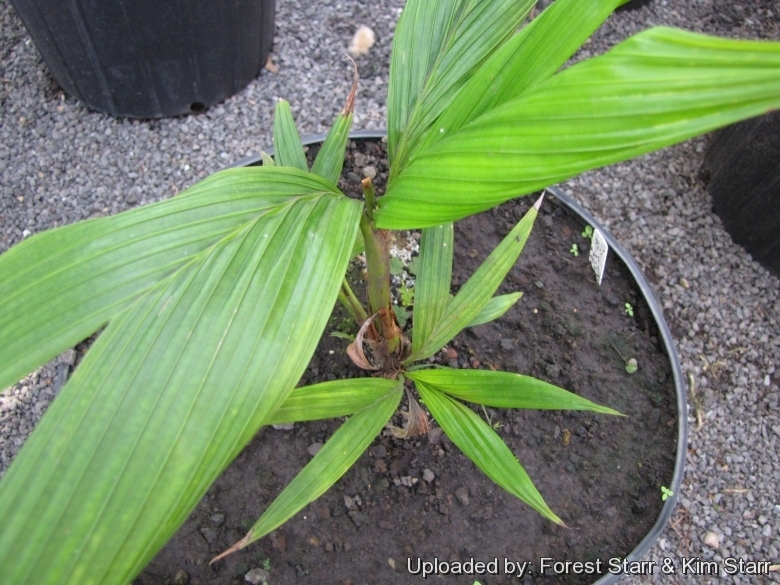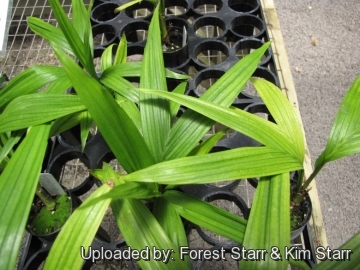Accepted Scientific Name: Calyptrocalyx hollrungii (Becc.) Dowe & M.D.Ferrero
Blumea 46: 226 (2001)

Linospadix hollrungii (Calyptrocalyx hollrungii) Photo by: Forest Starr & Kim Starr
In pot at Iao Tropical Gardens of Maui, Maui, Hawaii (USA). May 22, 2012.
Origin and Habitat: Calyptrocalyx hollrungiiSN|28476]]SN|28476]] is found in E. New Guinea, Rainforest, of Huon Peninsula.
Habit and ecology: It is a small understory palm native to the humid rainforests.
Synonyms:
See all synonyms of Calyptrocalyx hollrungii
back
Accepted name in llifle Database:Calyptrocalyx hollrungii (Becc.) Dowe & M.D.FerreroBlumea 46: 226 (2001)Synonymy: 7
back
Common Names include:
ENGLISH: New Guinea palm
Description: Calyptrocalyx hollrungiiSN|28476]]SN|28476]] is a small clumping palm with many slender stems conspicuously ringed by leaf scars and with a highly variable leaf shape. While the foliage of this palm mature to various shades of green it is often bright orange-red when emergent.
Habit: It is a small clustering palm that and will start to sprout small sucklings after a few years of life. It forms dense clumps and can reach heights of around 2-2.5 meters or so, depending on its location.
Stems (trunk): Slender, several from the base that may dichotomize (split into two growing points).
Leaves. 40 to 50 cm long with deep corrugations and medium green, variable in shape, ranging from a single bi-fold shape to entirely pinnate. The different leaf shapes have even been recorded on a single clump. New leaves emerge a deep maroon or orange-red colour and stay that colour for a few weeks.
Inflorescence: Usually an unbranched, interfoliar spike with unisexual flowers of both sexes; both pistillate and staminate flowers have three sepals and three petals.
Fruits: Orange-red when mature, each containing one seed.
Bibliography: Major references
1) Forest & Kim Starr Calyptrocalyx hollrungii (New Guinea palm). Plants of Hawaii. <http://www.starrenvironmental.com>. Downloaded on 21 August 2014.
2) Don Ellison, Anthony Ellison “Cultivated Palms Of The World” UNSW Press, 01/mag/2001
3) Robert Lee Riffle, Paul Craft “An Encyclopedia of Cultivated Palms” Timber Press, Portland 2007
4) John Dransfield, Natalie W. Uhl, Conny B. Asmussen, William J. Baker, Madeline M. Harley, Carl E. Lewis: “Genera Palmarum. The Evolution and Classification of Palms.” Royal Botanic Gardens, Kew 2008
5) William J. Baker, John Dransfield “Field Guide to the Palms of New Guinea” Kew Pub., 2006
6) Dransfield, J., N.W. Uhl, C.B. Asmussen-Lange, W.J. Baker, M.M. Harley & C.E. Lewis. 2008. “Genera Palmarum - Evolution and Classification of the Palms.” Royal Botanic Gardens, Kew.
7) Palmpedia contributors. “Calyptrocalyx hollrungii” Palmpedia/TropiScape, <http://www.palmpedia.net> Web. 22 Aug. 2014
8) Charlie Beck “GROWING Calyptrocalyx IN PALM BEACH COUNTY” http://www.palmbeachpalmcycadsociety.com/palms/documents/Calyptrocalyx.pdf
 Seedlings for sale at Iao Tropical Gardens of Maui, Maui, Hawaii (USA). May 22, 2012. (Calyptrocalyx hollrungii) Photo by: Forest Starr & Kim Starr
Seedlings for sale at Iao Tropical Gardens of Maui, Maui, Hawaii (USA). May 22, 2012. (Calyptrocalyx hollrungii) Photo by: Forest Starr & Kim StarrSend a photo of this plant.The gallery now contains thousands of pictures, however it is possible to do even more. We are, of course, seeking photos of species not yet shown in the gallery but not only that, we are also looking for better pictures than those already present.
Read More... Cultivation and Propagation: Calyptrocalyx hollrungiiSN|28476]]SN|28476]] is a rare small clumping palm with many slender stems mainly cultivated for its colourful new leaves by specialist palm growers and botanical gardens in tropical countries, but still scarcely known in cultivation. It is a shade-loving palm adapt to tropical climates and makes a good indoor container plant.
Growing rate: Slow growing.
Soil requirements: It has a fibrous root system and benefits from deep rich soil which keeps moisture but drains fast since water logging must be avoided.
Watering: Water regularly; do not overwater. During the summer or warmer months, water frequently to keep the soil from drying out..
Light: Will grow better in grows best in semi-shade or full shade, but tolerates morning sun. Seedlings like a more sheltered area.
**Fertilization: Need a perfect fertilizer diet including all micro nutrients and trace elements.
Aerosol salt tolerance: Not known.
Wind tolerance: It needs wind protection. Dry winds easily damage or kill it.
Hardiness: USDA Zones (9b-)10-11 It is cold tender and must be protected from cold. It is suited for tropical or subtropical climate and require protection from cold.
Uses: None recorded. It is of no particular merit as a source of cane for rattan handicrafts.
Garden uses: It is rarely cultivated, but is a very tropical looking excellent palm. Young plants have a small stature and the shape and colour of the leaves has the potential to be used as an ornamental plant. It is ideal where garden space is limited and a small plant is required. It is a great collector's palm.
Hazard: Has spiny stems and leaves.
Propagation:*** Fruit is small and red when ripe and seed germinates in 2 to 4 months with bottom heat. It can also be propagated by division of suckers.










